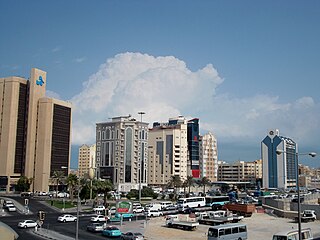
The history of Qatar spans from its first duration of human occupation to its formation as a modern state. Human occupation of Qatar dates back to 50,000 years ago, and Stone Age encampments and tools have been unearthed in the Arabian Peninsula. Mesopotamia was the first civilization to have a presence in the area during the Neolithic period, evidenced by the discovery of potsherds originating from the Ubaid period near coastal encampments.
Jasim bin Jabir, also known as Raqraqi, was a 19th-century pirate active in the Persian Gulf.

Zubarah, also referred to as Al Zubarah or Az Zubarah, is a ruined, ancient town located on the northwestern coast of the Qatar peninsula in the Al Shamal municipality, about 65 miles from the capital Doha. It was founded by Shaikh Muhammed bin Khalifa, the founder father of Al Khalifa royal family of Bahrain, the main and principal Utub tribe in the first half of the eighteenth century. It was designated a UNESCO World Heritage Site in 2013.

Al Wakrah is the capital city of the Al Wakrah Municipality in Qatar. Al Wakrah's eastern edge touches the shores of the Persian Gulf and Qatar's capital Doha is situated to the city's immediate north. Governed by Sheikh Abdulrahman bin Jassim Al Thani, it was originally a small fishing and pearling village. Over the years, it evolved into a small city with a population of more than 80,000 and is currently considered the second most populous city in Qatar.
Al Jalahma is an Arab clan, based primarily in the Arab States of the Persian Gulf. They are derived from the `Anizzah tribe of Northern Central Arabia. They were one of the four Utub clans who founded the modern state of Kuwait in 1716, along with Al Bin Ali, Al Sabah and Al Khalifa.
Al Bin Ali is a Sunni Arab sub-tribal confederation based in the Arab states, especially in Bahrain, Qatar, Kuwait, UAE, and the Eastern Province of Saudi Arabia.

Nuaija is a Qatari district in the municipality of Ad Dawhah. One of Nuaija's zones, Zone 41, was formerly known as Al Hilal West but was incorporated into Nuaija as of the 2010 census. Municipal authorities are developing district as a major mixed-use hub for south-central Doha.

Mushayrib is a Qatari district located in the municipality of Ad Dawhah. As of the 2010 census, the former district of Al Asmakh has been integrated into Mushayrib. It is one of the oldest districts of Doha, and contains Al Kahraba Street, the country's first fully lit street.

Fuwayrit is a Qatari coastal village in the municipality of Ash Shamal approximately 90 km north of the capital Doha. It is an important site for Qatar's oil industry. Archaeological evidence suggests that it may have been settled as early as the 16th century. Previously, it was one of the most important towns in the northern sector of Qatar, having served as the seat of power for the Al Thani who had migrated here during the 18th century, prior to relocating to Al Bidda in 1847.
Shaikh Isa Bin Tarif Al Bin Ali was chief of Al Bidda, known today as Doha, the capital of Qatar, as well as the chief of the Al Bin Ali tribe from the beginning of the 19th century until his death in 1847. He was described by the political agents in the Persian Gulf as being one of the most energetic and powerful chiefs in the Gulf region
The Bani Utbah is an Arab tribal confederation in the Arabian Peninsula. The confederation is thought to have been formed when a group of clans from Najd migrated to Eastern Arabia in the late 17th century and early 18th century. Most of the Utub clans and families, such as the Al-Sabah and Al-Khalifa, trace their lineage back to Anizah tribe, with the exception of some, such as the Al Bin Ali, whose lineage goes back to the Banu Sulaym tribe. The Al Bin Ali along with the current ruling families of Bahrain and Kuwait were the rulers of the federation. The name of the confederation is found in the form Attoobee or Uttoobee in English sources up to the late 19th century.

Al Bidda is a neighborhood of Doha, Qatar. It was previously the largest town in Qatar in the 19th century, before Doha, an offshoot of Al Bidda, grew in prominence. Al Bidda was incorporated as a district in the Doha municipality in the late 20th century.

Al Markhiya is a neighborhood of the Qatari capital Doha. It is one of the later-developed areas of northern Doha. The district hosts three awsaq al-furjan complexes, which are part of a public development project to host all commercial establishments in centralized areas.

Doha is the capital city and main financial hub of Qatar. Located on the Persian Gulf coast in the east of the country, north of Al Wakrah and south of Al Khor, it is home to most of the country's population. It is also Qatar's fastest growing city, with over 80% of the nation's population living in Doha or its surrounding suburbs.

The Qatari-Bahraini War, also known as the Qatari War of Independence, was an armed conflict that took place in 1867 and 1868 in the Persian Gulf. The conflict pitted Bahrain and Abu Dhabi against Qatar. The conflict was the most flagrant violation of the 1835 maritime truce, requiring British intervention. The two emirates agreed to a truce, mediated by the United Kingdom, which led to Britain recognizing the Al-Thani family of Qatar as the semi-independent ruler of Qatar. The conflict resulted in wide-scale destruction in both emirates.

Piracy in the Persian Gulf describes the naval warfare that was prevalent until the 19th century and occurred between seafaring Arabs in Eastern Arabia and the British Empire in the Persian Gulf. It was perceived as one of the primary threats to global maritime trade routes, particularly those with significance to British India and Iraq. Many of the most notable historical instances of these raids were conducted by the Al Qasimi tribe. This led to the British mounting the Persian Gulf campaign of 1809, a major maritime action launched by the Royal Navy to bombard Ras Al Khaimah, Lingeh and other Al Qasimi ports. The current ruler of Sharjah, Sultan bin Muhammad Al Qasimi argues in his book The Myth of Piracy in the Gulf that the allegations of piracy were exaggerated by the East India Company to cut off untaxed trade routes between the Middle East and India.

Al Wajbah is a district in Qatar, located in the municipality of Al Rayyan. It lies10 miles west of the capital Doha. The village was the site of the Battle of Al Wajbah, an armed conflict between the Ottomans and the Qatari tribes in 1893. It was blockaded by the Ottomans in March 1893. The main encounter took place later that month in the village's Al Wajbah Fort.

Al Kheesa is a village in the municipality of Al Daayen in Qatar. It was demarcated in 1988. It is approximately 3 km south of Rawdat Al Hamama.

Al Shagub is a district of Al Rayyan City in Qatar, located in the municipality of Al Rayyan. Since it houses the universities in Qatar Foundation's educational project Education City, the district is sometimes referred to as Education City. Qatar Foundation has played a major role in developing the district.

The Persian Gulf campaign of 1819 was a British punitive expedition, principally against the Arab maritime force of the Al Qasimi in the Persian Gulf, which embarked from Bombay, India in November 1819 to attack Ras Al Khaimah. The campaign was militarily successful for the British and led to the signing of the General Maritime Treaty of 1820 between the British and the Sheikhs of what was then known as the "Pirate Coast", would become known as the "Trucial Coast" after this treaty. Today, the territory comprises much of the United Arab Emirates.















